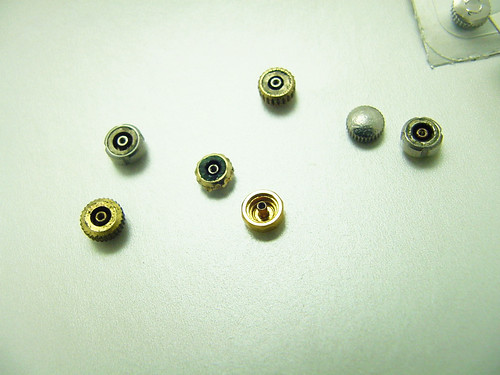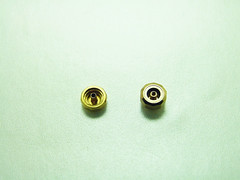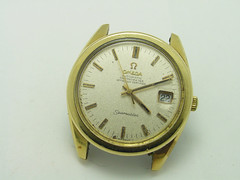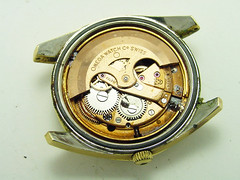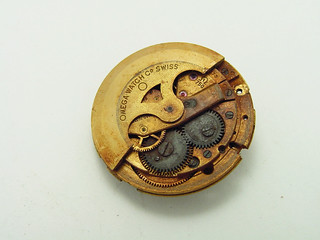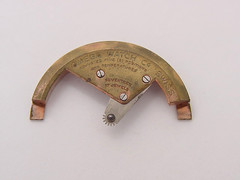omegaaddict.com
This post is a bit of information about Omega watch crowns. It goes for any brand of watch.
A watch crown is a "disposable" part. It gets used and worn, it will need to be replaced when it is past it's service life. Failure to do so can easily end the service life of your watch. Here are some pictures of used crowns I have replaced. If I asked you to pick the best crown out of the lot, the center one would be the number one pick for sure.
Now I have flipped them over and you can see the best looking crown is by far the worst of the lot. The retainer ring and gasket are missing making it not only worthless, but it puts your watch at great risk of water damage.
I get this request all the time when I am servicing a watch, "Please leave the original crown."
Sorry, I cannot if the old crown will not do its job. An Omega Constellation would be better served with a new Bulova crown than a bad original Omega crown.
Here is a beautiful Seamaster Chronometer. Bad gasket in the crown caused quite a bit of water damage. Trust me, you don't want this to happen to your watch! This will run up the repair cost by the time I get done. Many parts cannot be saved and will cost far more than the new crown it should have had. Below is another picture of a movement that came out of a watch with a bad crown.
When I shop for watches I disregard the disposable parts; crown, crystal and band. All can be easily changed. Being a watchmaker the first thing I do when I get a watch is check to see the condition of the crown if I am going to wear it. I recommend you do the same or have your watchmaker check it out.
Omega and other brands have discontinued many models of crowns. Most can still be found with an on-line hunt. It is nice to have an original style crown on a watch. However, an aftermarket crown is just fine while you are hunting for an original.
Tim Mackrain - Restoration, Repair & Service of Omega Mechanical Watches @ omegaaddict.com
Tuesday, June 21, 2016
Omega Parts Restoration
omegaaddict.com
Was not quite sure where to start on this project. Started with good guesses, I thought. Turned out to be a bit more of a project to figure out than I had imagined.
The first several attempts with the use of too much copper in the mix would quickly patina. I would end up with a part looking far worse than when I started, almost like a well-aged penny.
I searched for counsel of plating experts. I thought for sure they could help. Turns out not so much. Most had no idea why I would want such a mix of metals and had never tried such a thing. It was back to the drawing board. I was sure rhodium could help; hard, bright, and with a touch of copper. I tried again with another mix. Looked amazing for a few weeks but the copper in the plating eventually succumbed to its usual patina. I put this project on the shelf a while, the question still on my mind.
One day I was talking to a coin collector. We got on the subject of plating. He tells me right out, “Kugerand! That's what you need.” A Kugerand is a beautiful and highly collectible African coin consisting of 91.67% gold and 8.33% copper. Interesting mix of metals to be sure! I started out again using a similar mix a lot closer to the Kugerand than I had tried before. Having a look at other coins I kept on experimenting with batch after batch till I got it down. Now I can get a nice color that holds up well with time.
Sorry can't tell you what I ended up with, that is a proprietary secret! My conclusion is that restoring the plating on Omega parts in this way is very time consuming and expensive to be sure. Plating is not essential to the functionality/running of a movement. Nice touch though when needed. Most parts are available if you take the time to look. Much easier to replace than restore a part. On a rare watch where a part can’t not be found and the parts is still functioning a restoration is in order.
A challenge I have enjoyed!!
Was not quite sure where to start on this project. Started with good guesses, I thought. Turned out to be a bit more of a project to figure out than I had imagined.
The first several attempts with the use of too much copper in the mix would quickly patina. I would end up with a part looking far worse than when I started, almost like a well-aged penny.
I searched for counsel of plating experts. I thought for sure they could help. Turns out not so much. Most had no idea why I would want such a mix of metals and had never tried such a thing. It was back to the drawing board. I was sure rhodium could help; hard, bright, and with a touch of copper. I tried again with another mix. Looked amazing for a few weeks but the copper in the plating eventually succumbed to its usual patina. I put this project on the shelf a while, the question still on my mind.
One day I was talking to a coin collector. We got on the subject of plating. He tells me right out, “Kugerand! That's what you need.” A Kugerand is a beautiful and highly collectible African coin consisting of 91.67% gold and 8.33% copper. Interesting mix of metals to be sure! I started out again using a similar mix a lot closer to the Kugerand than I had tried before. Having a look at other coins I kept on experimenting with batch after batch till I got it down. Now I can get a nice color that holds up well with time.
Sorry can't tell you what I ended up with, that is a proprietary secret! My conclusion is that restoring the plating on Omega parts in this way is very time consuming and expensive to be sure. Plating is not essential to the functionality/running of a movement. Nice touch though when needed. Most parts are available if you take the time to look. Much easier to replace than restore a part. On a rare watch where a part can’t not be found and the parts is still functioning a restoration is in order.
A challenge I have enjoyed!!
Subscribe to:
Comments (Atom)

